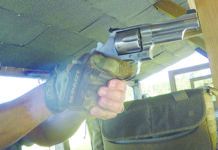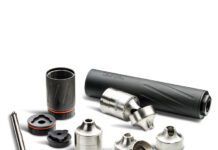The M&P45s feature a 4.6-inch barrel with an overall length of 8.0 inches. The M&P45 comes standard with three interchangeable grips, a steel dovetail mount front sight and a steel Novak Lo-Mount carry rear sight. Tritium sights are also available. A universal Picatinny-style equipment rail has been incorporated for tactical lights and lasers. Our polymer pistol had an empty weight of 25.1 ounces.
The new frame-mounted ambidextrous thumb safety acts as a passive safety device, allowing the slide to be pulled toward the rear, clearing the firearm without disengaging the safety. Another feature is the lanyard attachment. All M&P45 pistols feature a Zytel polymer frame reinforced with a stainless-steel chassis and a hardened black Melonite-finished stainless-steel barrel and slide and a Dark Earth Brown grip. This is a silly name for a color—Sand would have been fine—but we overlooked it.
A passive trigger safety prevents the pistol from firing if dropped, and a sear-release lever eliminates the need to press the trigger in order to disassemble the firearm. A loaded chamber indicator is located on top of the slide. The firearm also features an ambidextrous slide stop and a reversible magazine release, as well as an enlarged trigger guard designed to accommodate gloves. The Smith & Wesson lifetime service policy is standard with each pistol.
The barrel measured 4.6 inches in length, with a sight radius of 6.8 inches and an overall height of 5.5 inches. The frontstrap and backstrap heights were 2.5 inches and 3.8 inches, respectively. Across the ambi safety paddles, the gun’s maximum width taped out to be 1.6 inches, with the grip measuring 1.4 inches thick and 5.9 inches in circumference. Our test sample weighed 25.1 ounces with an unloaded magazine. The trigger pull weight single action was 8.0 pounds, and the trigger span of the gun cocked in single-action mode was 2.7 inches. Trigger travel rest to fire was 0.3 inches, and the trigger reset distance was 0.140 inch.
We liked a lot of things on the M&P45. Of course, to start it was slightly cheaper than the Glock and $600 cheaper than the H&K. It had impressive fit, finish, and cosmetics. For instance, we could see only the faintest line at the bottom of the grip where the pieces could be switched. The brown frame color offsets the black slide nicely, though the black pins in the brown frame didn’t look good to our eyes.
The gun is ambidextrous. Lefties had no trouble working the slide release or the safety, and the magazine release is reversible. The magazine release was a push-button design that could be changed to operate from the right side if desired—a boon for lefties, but the Glock and H&K guns had full-time ambi buttons, the H&K behind the trigger guard and the Glock in roughly the same place, but back into the frame, for good or ill.
Where the M&P gained an edge was in its 1911-style ambi safety paddles. Our test team loved that feature. 1911 shooters will welcome these levers, for they broaden the shooter’s choice of which condition to leave the gun in. Also, because the levers work all the time, the gun can be made safe loading, unloading, or working the slide. The Glock, of course, lacked this feature altogether, and the H&K had it on just the left-hand side. However, the H&K’s lever could be reversed.
One of the most important aspects of any pistol is the way it feels in the shooter’s hands, and the M&P feels good. We found the M&P’s grip angle to be to our liking. One of our testers called the M&P “a natural pointer” the first time he handled it, commenting that the grip angle reminded him of the 1911. The hand slips under the M&P’s beavertail better, and the thinner grip allowed the shooter’s hand to close around it better than the blockier Glock, we thought. Additionally, the optional backstraps allow shooters with different hand sizes to customize the grip for best fit. Unlike on the M&P40 we recently tested, we were able to extract the 45’s grip tool from its storage space and change grips. The Glock and H&K lacked this feature.
In more detail, the trigger face was hinged, and when the bottom of the trigger was pulled, it deactivated the striker block safety. The initial take-up disengaged the safety, then there was some creep and additional weight, then a bit of travel before a clean break at 8 pounds. Once pulled, a trigger stop hit a ridge on the inside of the trigger guard, which shortened the reset distance.
Elsewhere, the Novak sights were clear and easy to see; the frame included an accessory rail, and the wavy slide serrations provide a great grasping surface for working the slide without discomfort. The double-stack, 10-round magazine doesn’t cause the grip to be bulky. Also, with a 10-round count, it’s easy to calculate and count the total rounds you’re carrying and what you have shot, and what you have left. Under stress, it’s amazing how difficult it is to multiply times 7, 8, or 13.
From the bench, the M&P45 printed its best five-shot groups with Aguila’s 117-grain hollowpoints (1.4 inches), followed by the Sellier & Bellot 230-grain FMJs (1.5 inches) and Hornady’s 230-grain JHP/XTPs (1.8 inches). That was better than the Glock and H&K using the high-speed Aguila ammo and the S&B ball round, but behind the H&K with Hornady load.
Elsewhere, the M&P’s external extractor helped the gun function without flaw. The rear Novak low mount sight with two white dots was adjustable for windage only. The barrel hood offered a hole at the rear that extended into the breech face for visual inspection of the chamber. The ejection port in the slide was large. The well-built blued magazines were numbered 3 to 10 on the back side of the magazine, with the only weird thing being that the 9 hole was lower than the 10-hole.
But the gun’s not perfect. We found very sharp points on the front of the frame under the guide rod. This is a ticky-tacky point, because the other guns had the same problem, and that part of the frame isn’t exposed. And the M&P45 was the most difficult of the test guns to field-strip.
Also, we had trouble loading the ninth and tenth rounds into one magazine, and we couldn’t load the tenth round into the second magazine. We also noticed that when releasing the slide, it’s possible to engage the safety inadvertently. If you train with it, snapping the safety back down after a reload won’t be a problem, but if you’re not aware of it and you’ve shot a full magazine, reloaded, and snapped the slide home expecting the gun to go bang when you pull the trigger, then the safety lever being up could be a problem.






















